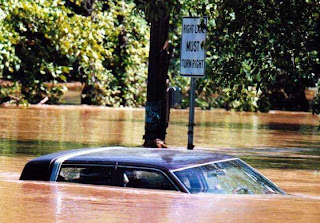It has been six years since Hurricanes Katrina and Rita swept through parts of Louisiana and Texas, causing thousands of vehicles affected by the floods to appear at dealer lots all around the country. So with the recent floods from the Northeast and Midwest we expect that a lot of flood-damaged vehicle will end up around the country again.
Unlike non-flood damaged vehicles, flood damaged vehicles are typically worth 40% to 60% less than non-flood damaged vehicles.
Just as we learned after the financial markets nearly collapsed -- that there had been no government regulations, which lead to the current economic climate, the same is also true for the used car market, too, as it relates to the industry not being regulated. By this, we mean, still today there isn't a national unified system that has been put in place from state-to-state for used car buyers (or state officials) to track flood damaged or, for that matter, stolen vehicles.
Conversely, like a mid-day traffic jam, political wranglings with the insurance companies and a number of state governments (and legislatures) have placed used car buyers at the crossroads, while the American public continues to wait for Congress to pass a bill.
So in the midst of awaiting for Congress to implement a unified national vehicle data base, consumers must take every necessary precaution to minimize the risk of purchasing a flood damaged vehicle. In order to do this, we have gathered some tips we provided to The Washington Post and to a number of other media sources over the past few years:
Be sure and check the history of the vehicle. If you have to pay for a report, do it. With that history in hand you'll find out such things as whether the car was in a flood or sustained major damage in an accident. You can check for odometer fraud. And we also that you invest a vehicle history report like AutoCheck.com. Investing in this report could make the difference between buy a flood-damaged vehicle or steering clear of one. (AutoCheck is a more comprehensive report than CarFax.)
As a second line of defense, have a trained, certified mechanic inspect the vehicle.
Take the car for a test drive. Drive it on the highway so you can see how it reacts at high speeds. Drive it in stop-and-go traffic.
Check for water damage yourself. For example, if a car has a sunroof, look for a water ring around the opening. Pay particular attention if the carpet has been shampooed. If you notice an abnormal odor, this may be a sign of flood damage. If you smell mold, hit the road and don't look back. Look for rusty bolts and screws. We still recommend that a professional inspects the vehicle, before you seal the deal.
In addition to using the tips featured in The Washington Post, click here to peruse the government database to make sure sure you're not buying a stolen or re-titled vehicle.
You’re watching Raw Video: Vermont Flood Washes Car Away.
By following the aforementioned steps, this should help consumers steer clear of flood-damaged vehicles which are expected to appear around the country and in the hands of unsuspecting consumers.
And before buying a used vehicle, take a moment to view this video too.







4 comments:
Great warning, this is something a lot of people overlook when buying second-hand. Flood-damaged vehicles can look fine on the surface but be hiding all sorts of issues underneath. It is always worth checking the history properly before handing over any cash. If you do end up stuck with a dud, sometimes the best move is to call cash for unwanted cars Adelaide and cut your losses. Thanks for sharing this – really useful info!
This is such an important warning—thank you, Jeff, for sharing this eye‑opening guide! Flood‑damaged vehicles can be ticking time bombs, with hidden electrical issues, corrosion, and safety risks that aren’t obvious at first glance. Any buyer should demand a comprehensive inspection, full vehicle history, and a look for signs like water lines, musty smells, or peeling paint. Even “repairable autos.” that seem affordable can turn into costly nightmares if not properly vetted and repaired. Your cautionary advice is essential for anyone in the market. For me, this really reinforces the need for diligence and professional assessment.
paanwc031gs
golden goose outlet
golden goose outlet
golden goose outlet
golden goose outlet
golden goose outlet
golden goose outlet
golden goose outlet
golden goose outlet
golden goose outlet
golden goose outlet
Post a Comment